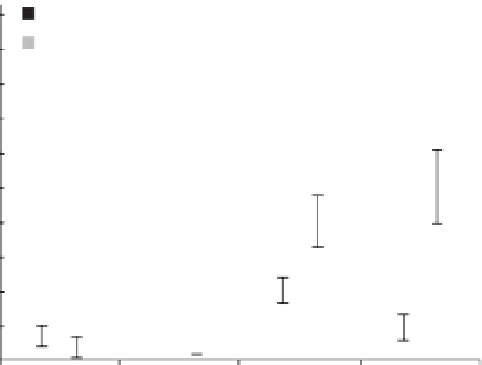Agriculture Reference
In-Depth Information
feedforward regulation. In a previous study, we
found that during the early stages of tuber devel-
opment
StGA20ox1
was upregulated, possibly
under the influence of negative feedback regula-
tion as a result of reduced GA
1
levels in the sto-
lon (Kloosterman
et al.,
2007). However, other
studies have shown that StBEL5 is able to reduce
StGA20ox1
expression, together with its partner,
POTH1 (Chen
et al.,
2004), and both genes are
highly induced on transfer to SD conditions
(Fig. 4.3
). These apparently contrasting results
may be explained through the cell-type dependent
interaction of StBEL5-POTH1 with the
StGA20ox1
promoter in cells surrounding the vascular bun-
dle (Banerjee
et al.,
2006). In our tuber develop-
mental studies, RNA from whole tuber extracts
was collected, which did not allow a distinction
between the different cell types present within
the tuber.
in the tuber during early tuber developmental
stages in both the stolon apex and the subapical
stolon region (Roumeliotis
et al.,
2012) (
Fig. 4.6
).
Increased transcription levels of a potato IAA
biosynthesis gene (
StYUC-like1
) provide further
evidence for the increase of auxin during tuber
development (Roumeliotis
et al.,
2012)
.
In earl-
ier studies linking IAA content with tuberiza-
tion, a small promoting effect for auxin was
observed. However, due to lack of accurate
auxin measurements within the stolon and
tuber tissues, as well as different modes of appli-
cation, data interpretation was difficult. For
example,
in vitro
application of auxin to single
nodal potato explants resulted in an earlier tuber-
ization phenotype with sessile and slightly small-
er tubers (Xu
et al.,
1998a), whereas Harmey
et al
. (1966) observed that IAA treatment in-
duced larger tubers at an earlier stage. Interest-
ingly, when auxin is applied apically to
in vitro
stolon explants with their apex removed, tuber
formation from the lateral buds is initially reduced
or delayed, but the final number of tubers is
higher due to lowered inhibition of axillary bud
outgrowth. This increase in total number of
tubers is probably due to auxin degradation
in the medium, because renewal of the IAA-
containing medium prolongs the inhibition of
tuber formation (Roumeliotis
et al.,
2012).
Auxin
A second plant hormone impacting tuber devel-
opment is auxin (IAA). This plant hormone has
been less studied compared to GA, and its role in
tuberization has not always been clear. Recently,
it was shown that IAA concentration was elevated
5000
Apex and subapical region
Stolon below subapical region
4000
3000
2000
1000
0
0
5
16
26
Days in SD
Fig. 4.6.
Auxin measurements in the apical and subapical region and the stolon region below the
subapical region after the switch to SD conditions. Plants were transferred to SD conditions (day 0) and
monitored for tuber formation. On day
5,
no visible signs of tuber formation were observed and stolons
were harvested. Small tubers were present on day
16
and larger tubers were harvested on day
26,
and
auxin concentration was determined (Roumeliotis
et al.,
2012).





